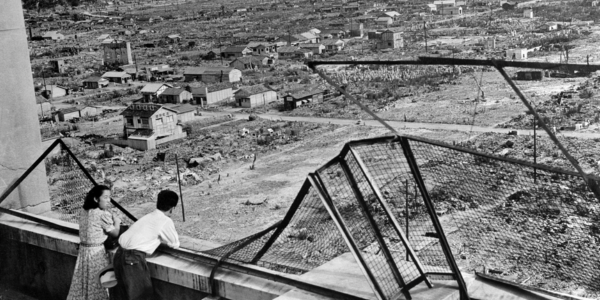
Bulletin of the Atomic Scientists, August 7, 2023
Posted: 7th August 2023
August 7, 2023

Looking south on the first anniversary of the Hiroshima bombing on August 6, 1946. (Getty Images)
NUCLEAR RISK
Before Hiroshima
The May 1, 1946 edition of the Bulletin featured the declassified version of the June 1945 Franck Report, which argued for not bombing Japanese cities. Read more.
NUCLEAR RISK
Rapid Dragon: The US military game-changer
The new Rapid Dragon system, which converts cargo aircraft into weapons carriers that can deploy cruise missiles, is a game-changing concept that could complicate arms control efforts, writes nuclear security expert George M. Moore. Read more.
NUCLEAR RISK
Nuclear weapons since Oppenheimer: Who’s in control?
After Oppenheimer, policy makers of nuclear-armed countries have let the interests of their military and arms producers control these weapons, writes MIT physicist Lisbeth Gronlund. Read more.
NUCLEAR RISK
Counting the dead at Hiroshima and Nagasaki
How many people died because of the Hiroshima and Nagasaki bombings? Nuclear historian Alex Wellerstein aimed to answer this question in this 2020 article that appears here in remembrance of this year’s anniversary of the bombings. Read more.

Experts discuss our nuclear future in light of the release of Oppenheimer
On August 3, 2023, the Bulletin and The Elders held a discussion about our shared nuclear history, current challenges, and possible futures. The conversation featured commentary from a world-renowned nuclear physicist, a survivor of the bombing of Hiroshima, and a former president of Colombia.
NUCLEAR RISK
The test ban treaty at 60: How citizen action made the world safer
Sixty years ago, the United States, Soviet Union, and United Kingdom—which had conducted over 500 above-ground nuclear tests—agreed to end testing in the atmosphere, under water, and in outer space. The Limited Test Ban Treaty became the first international environmental treaty curtailing the poisoning of Earth. Read more.
NUCLEAR RISK
Oppenheimer depicts a man becoming powerful—and irrelevant
Oppenheimer did not have the temperament and skills to confront the US political and military leadership on critical decisions about nuclear weapons, writes scientist Laura Grego. Read more.
QUOTE OF THE DAY
“In an interview with the Bulletin of the Atomic Scientists, Nolan said that he made the film partly because only the Bulletin and the Doomsday Clock exist to remind us of the “terrible situation” we’re in with nuclear weapons. And, partly, because the real Oppenheimer was a person of such sharp contradictions.”
— Matthew Gault, “The People Building AI with ‘Existential Risk’ Are Really Not Getting Oppenheimer,” VICE
Your ongoing support ensures we stay on mission and get the job done.
Thank you!

